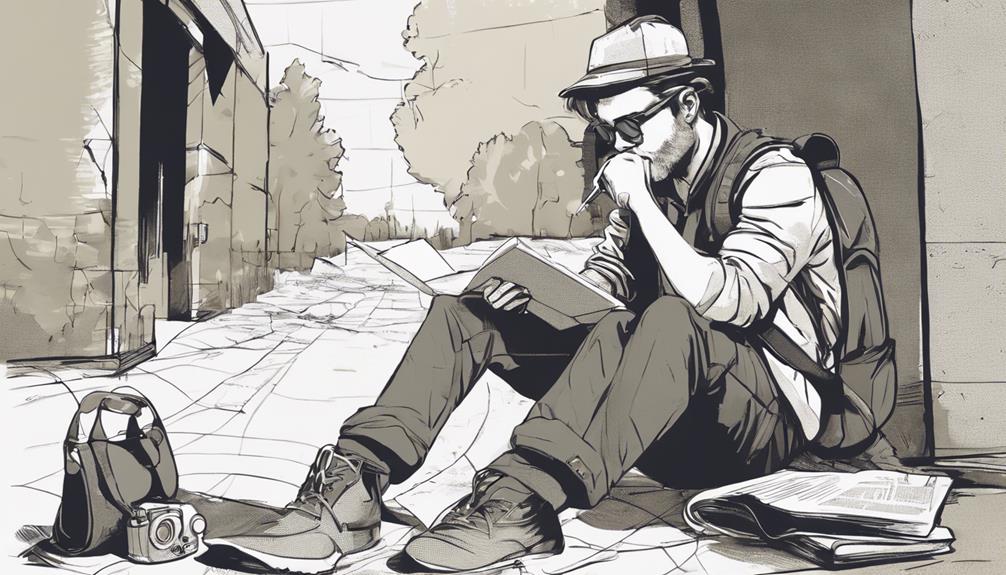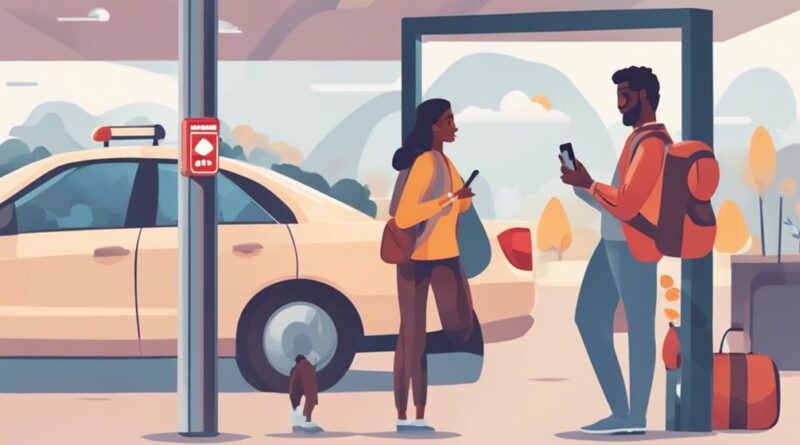Guide to Safe Solo Travel: Rest Stop Tips
Have you ever wondered if where you choose to stop for a quick rest while traveling solo could impact your safety?
Making informed decisions about rest stops is crucial for your well-being on the road. You might think it's just a quick pit stop, but the choices you make during these breaks can make all the difference in ensuring a smooth and secure journey.
Stay tuned to discover essential tips that will help you navigate rest stops with confidence and peace of mind.
Importance of Rest Stop Safety
Staying vigilant at rest stops is crucial for ensuring your safety while traveling solo. Rest stop awareness is key – always be mindful of your surroundings and trust your instincts. As you pull into a rest stop, scan the area for well-lit spaces and preferably those with other travelers around. Park in a spot that's visible and close to the main building. Before exiting your vehicle, lock the doors and take your valuables with you.
As you walk towards the facilities, keep a confident and alert demeanor. Thieves and predators often target individuals who appear distracted or vulnerable. If you sense any unease, trust your gut and consider finding another rest stop. While inside, be mindful of those around you and avoid engaging in conversations with strangers that make you uncomfortable. It's always better to be cautious than to ignore potential warning signs.
In addition to rest stop awareness, it's valuable to familiarize yourself with basic self-defense techniques. Consider taking a self-defense class before your trip to learn essential moves that could protect you in dangerous situations. Knowing how to defend yourself can boost your confidence and help you feel more secure during your travels. Remember, your safety is a priority, so take the necessary precautions to ensure a smooth and secure solo journey.
Choosing Safe Rest Stops
To ensure your safety while traveling solo, be mindful of selecting well-lit and populated rest stops with other travelers around. When choosing a rest stop during your solo travels, consider the following:
- Restroom hygiene: Opt for rest stops that maintain clean and well-maintained restrooms. Proper sanitation in the restrooms reduces the risk of exposure to germs and bacteria, promoting a healthier environment for your pit stop.
- Food options: Look for rest stops that offer a variety of food options. Having access to different types of food can cater to your preferences and dietary restrictions. It's essential to refuel your body with nutritious snacks or meals during your journey.
- Crowd presence: Select rest stops that are frequented by other travelers. A populated rest stop provides a sense of security and decreases the likelihood of encountering potentially unsafe situations. The presence of other people can deter any unwanted attention and offer assistance if needed.
Lighting and Visibility
For optimal safety during solo travel, prioritize well-lit rest stops with high visibility to minimize potential risks. When selecting a rest stop, always opt for locations that have adequate lighting in parking areas, walkways, and around facilities. Safety measures such as proper illumination help deter criminal activities and provide a sense of security.
To enhance visibility at rest stops, choose spots that have bright overhead lighting or are located in well-lit areas. Avoid secluded rest stops with poor lighting, as they can make you an easy target for theft or harm. Visibility enhancement is crucial for your safety, especially during nighttime stops or in dimly lit areas.
When pulling into a rest stop, take note of the lighting conditions. If the lighting is inadequate or if certain areas are poorly lit, consider moving to a different spot or a different rest stop altogether. Your safety should always come first, so don't hesitate to prioritize well-lit areas even if it means traveling a bit further down the road.
Parking in Well-Lit Areas
When parking during solo travel, how can you ensure your safety by choosing well-lit areas?
Opting for well-lit parking areas is a crucial step in staying safe during your solo adventures. Here's how you can enhance your safety:
- Choose Well-Lit Areas:
Parking in well-lit spots not only deters potential threats but also increases visibility. This can help you locate your vehicle easily and be aware of your surroundings.
- Look for Security Cameras:
Opt for parking areas equipped with security cameras. These cameras act as a deterrent to criminals and provide an added layer of security for your vehicle and yourself.
- Consider Travel Buddies:
If possible, try to park near other vehicles or in areas where there are other travelers around. Safety in numbers is a real concept, and having other people nearby can offer additional security.
Keeping Valuables Secure
Make sure your valuables are kept secure by utilizing hidden compartments or lockboxes in your vehicle. When traveling solo, it's essential to take precautions to safeguard your belongings. Hidden compartments within your car provide a discreet way to store valuables out of sight, reducing the risk of theft. Consider installing aftermarket hidden compartments or using existing ones if your vehicle is equipped with them. These compartments can be used to store items like cash, electronics, or important documents securely.
In addition to hidden compartments, locking mechanisms add an extra layer of security. Lockboxes that are securely attached within your vehicle can serve as a safe space for storing valuables while you're on the road. Look for lockboxes that are durable and tamper-resistant to deter any potential thieves. Make it a habit to store your valuables in these secure compartments whenever you make a stop, even if it's just for a short break.
Remember to keep the existence of these hidden compartments and lockboxes discreet. Avoid drawing attention to where you store your valuables, especially in public areas. By implementing these measures, you can minimize the risk of theft and travel with peace of mind knowing that your belongings are well-protected.
Emergency Contacts and Apps
To enhance your safety while traveling solo, ensure you have designated emergency contacts and useful apps readily accessible. Having these resources at your fingertips can provide peace of mind and quick assistance in case of any unforeseen circumstances.
Here are three key points to consider:
- Emergency Contacts:
Make sure to have a list of emergency contacts saved on your phone. Include family members, friends, or even local authorities you can reach out to in case of an emergency. It's crucial to have someone who can assist you if needed.
- Safety Apps:
Download safety apps designed for solo travelers. These apps often offer features like real-time location sharing, emergency alerts, and direct contact with emergency services. Examples of such apps include bSafe, Noonlight, and TripWhistle.
- Regular Check-Ins:
Set up a system for regular check-ins with your emergency contacts. Whether it's a simple text message at designated times or using features within safety apps that allow for periodic check-ins, staying connected can ensure someone is aware of your whereabouts.
Trusting Your Instincts

Listen to your gut feelings when traveling alone, as they often serve as your best guide to staying safe. Trusting your instincts is crucial in maintaining your personal safety. If a situation or person feels off, it's essential to listen to that inner voice. Your intuition can often pick up on subtle cues that your conscious mind may not register immediately.
When it comes to self-defense, always be prepared. Take basic self-defense classes to equip yourself with techniques that could potentially save you in dangerous situations. Additionally, carry a personal safety alarm or a small canister of pepper spray in easily accessible places like your pocket or purse. These tools can provide an added layer of protection and peace of mind.
Setting clear personal boundaries is key to staying safe while traveling solo. Be assertive in communicating your limits to others, whether it's declining unwanted advances or firmly saying no to activities that make you uncomfortable. Remember, it's okay to prioritize your safety and well-being above being polite or accommodating.
Planning Ahead for Safety
Planning ahead for safety involves assessing potential risks and preparing accordingly to mitigate them effectively. When embarking on a solo journey, it's crucial to anticipate various scenarios that could potentially jeopardize your safety. Here are some essential tips to help you plan ahead and stay safe during your travels:
- Emergency Kit: Pack an emergency kit that includes essentials such as a first aid kit, flashlight, extra water, non-perishable snacks, a blanket, and any necessary medications. Having these items readily available can make a significant difference in case of unexpected emergencies.
- Roadside Assistance: Before hitting the road, ensure you have reliable roadside assistance coverage. Whether through your insurance provider or a separate service, having access to roadside assistance can offer peace of mind knowing that help is just a phone call away in case of a breakdown or other vehicle-related issues.
- Safety Apps: Consider downloading safety apps that can provide real-time updates on your location, offer emergency assistance features, or allow you to share your whereabouts with trusted contacts. These apps can be valuable tools for enhancing your safety while traveling solo.
Frequently Asked Questions
What Should I Do if I Encounter a Suspicious Individual at a Rest Stop?
If you encounter a suspicious individual at a rest stop, trust your instincts and act on avoidance tactics. Stay alert, keep your distance, and avoid engaging with them.
If necessary, seek help from authorities or move to a safer location. It's essential to prioritize your safety and well-being in such situations.
Are There Any Specific Self-Defense Techniques I Should Learn Before Embarking on a Solo Trip?
Before your solo trip, learn basic self-defense techniques. Understanding defensive strategies can empower you to protect yourself in unexpected situations.
Take a self-defense class to gain confidence and skills that could be crucial in keeping you safe during your travels.
Being prepared with these techniques can give you peace of mind and a sense of readiness as you embark on your journey.
How Can I Discreetly Signal for Help if I Feel Unsafe at a Rest Stop?
If you're feeling unsafe at a rest stop, you can discreetly signal for help by using emergency signals like waving your hand with a closed fist or blinking your car lights. It's essential to stay alert and prepared by learning self-defense techniques and safety precautions beforehand.
Additionally, having communication methods like a whistle or a personal alarm can help attract attention and deter potential threats. Stay vigilant and trust your instincts to stay safe during your solo travels.
Are There Any Specific Rest Stop Amenities I Should Look for to Ensure My Safety?
To ensure your safety at rest stops, look for amenities like well-lit areas, security cameras, and emergency call boxes. These safety protocols can provide peace of mind during your travels.
Make sure to familiarize yourself with the location of emergency resources, such as first aid kits or contact numbers for authorities.
Prioritizing these features can help you feel more secure when taking a break during your solo journey.
How Can I Effectively Communicate My Location to Emergency Services in Case of an Incident at a Rest Stop?
To effectively communicate your location to emergency services at a rest stop, make sure to utilize features like:
- Emergency contacts
- GPS tracking
- Location sharing
- An SOS button
These tools can help authorities quickly locate you in case of an incident.
Always have these resources easily accessible on your phone or other devices for added safety and peace of mind during your travels.
Conclusion
Remember, when it comes to solo travel, your safety should always be a top priority.
By following the tips outlined in this guide, such as choosing safe rest stops, keeping valuables secure, and trusting your instincts, you can have a more enjoyable and worry-free journey.
Always remember to plan ahead, stay vigilant, and prioritize your well-being while on the road.
Safe travels!
